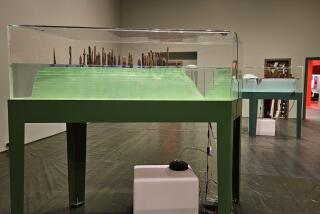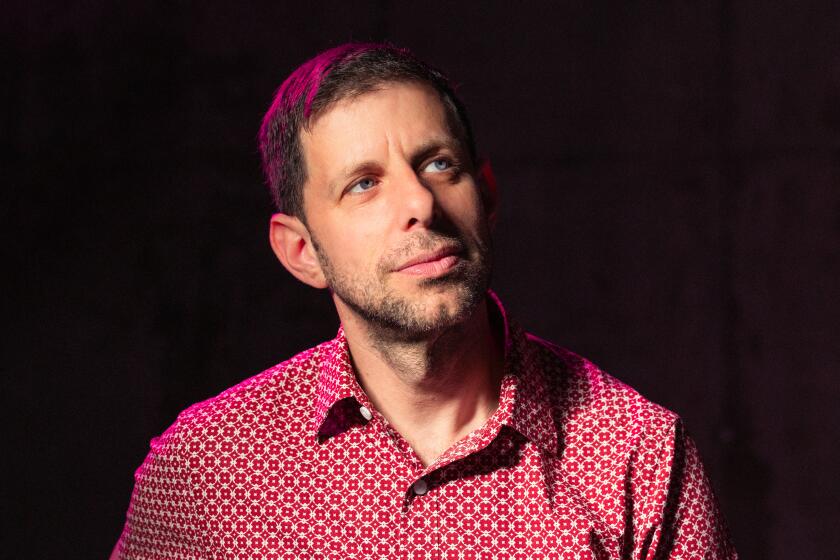Review: ‘Junk Dada’ assembles Noah Purifoy’s overlooked, pivotal works
Noah Purifoy may be the least well-known pivotal American artist of the last 50 years.
In the aftermath of the Watts rebellion, which tore up South Los Angeles in August 1965, sending shock waves across the country, Purifoy made an extensive series of assemblage sculptures that signaled a powerful, wholly unexpected cultural shift.
Working with a small circle of colleagues, he was instrumental in redefining — enlarging — an idea of black consciousness that had been established in 1920s New York during the Harlem Renaissance.
Ten of those early assemblages are at the start of “Noah Purifoy: Junk Dada,” the much-anticipated retrospective exhibition newly opened at the Los Angeles County Museum of Art. This is the artist’s second career overview, but it is nearly twice as large as the groundbreaking display organized in 1997 by curator Lizette Lefalle-Collins for the California African American Museum in Exposition Park.
Seventy works have been brought together by LACMA’s Franklin Sirmans and guest curator Yael Lipschutz. They include half a dozen monumental assemblages erected in Purifoy’s open-air environment in the Mojave Desert at Joshua Tree, most effectively installed on broad, sand-covered platforms.
Few of the 1966 works have been shown in recent years, so they offer an absorbing foundation for what follows. Most are modest in size — some as small as 10 inches, none as large as 3 feet. What they embody, however, is big.
The assemblages were cobbled together from the riots’ debris. Purifoy and artist Judson Powell began to salvage the material in great, weighty piles — 3 tons in all. They began almost as soon as the embers cooled and the smoke cleared.
Those charred and broken remnants of a place comprised an annealed history of lives lived. It represented the most recent stratum of social and cultural sediment built up over centuries. Under no circumstances could that be lost or plowed under.
Instead, reborn as art, it continues on.
“The City at Night” is an ethereal urban landscape. Layered bits of clear plastic, a few light-bulb fragments and a row of zipper-pulls and other metallic pieces are sandwiched inside a shallow, 2-foot-tall Plexiglas box.
The sculpture, reminiscent of a Joseph Cornell box from which the color has been drained, is a vision at once Utopian and pragmatic. It’s a portable promised land kept close.
Nearby, “Pressure” is a small, black and blue rectangle of what appears to be checkerboard linoleum held in a chipped white picture frame. A conundrum is attached at the center.
Some sort of gun-metal gray canister has been squashed and made useless, its flattened valve staring out like a Cyclopean eye. Uncannily poised, Purifoy’s composition has the look of a medieval icon.
Reconfiguring a crumpled carcass as an object of cultural veneration — a work of art — gives a mighty push-back to the physical force (or pressure) that has been leveled against it.
A similar sense of spirituality oozes from a relief made from a piano pedal studded with nails. Like a ritual sculpture from the Congo — an African nkisi nkondi, or traditional nail fetish — the assemblage is an ode to music as an inner life force, painful yet potent.
Perhaps the most powerful of the group is “Watts Riot,” a tall panel of charred wood. The heat of the inferno melted and fused its painted and plastered materials into a dense, lustrous abstraction. Haunting bits of collage can be glimpsed through its smoky, blistered surface.
A veritable Ur-object for Purifoy’s career — and for the development of art in Los Angeles and the United States — “Watts Riot” is unfortunately not in the show. The absence is wounding.
The wall relief is in the collection of the California African American Museum, where it is currently on view. A state museum, CAAM has been without a staff director for more than a year; according to a spokesman, interim leadership from Sacramento nixed the requested loan.
The decision was unfortunate, both for the art public and Purifoy’s legacy. These sculptures represent a pivotal evolution in assemblage art in general and African American art in particular.
Depictions of black humanity had been the focus of painting and sculpture that came out of the Harlem Renaissance in the 1920s and 1930s. The art was fueled by mass migration of African Americans from the South to the North. That epic journey is chronicled in Jacob Lawrence’s remarkable series of 60 tempera paintings currently being shown at New York’s Museum of Modern Art.
Purifoy, born in Alabama in 1917, was a child of the second great migration following World War II. He arrived in Los Angeles in 1950 after naval service in the South Pacific. The assemblages he would eventually make kept humanity as their focus while drastically changing their formal terms.
Painting, carving, casting and other traditional media were set aside. Instead, through suggestive deployment of ordinary found objects, he replaced a story’s expressive pictorial representation with a poetic, abstract evocation of it.
“Junk Dada” is what Sirmans and Lipschutz have smartly dubbed the practice. A marvelous, untitled 1967 relief is emblematic.
Against a tri-color surface whose wide bands of green, yellow and red suggest a Pan-African background (the colors derive from the Ethiopian flag), a flattened, skeletal umbrella implies both shelter and ruin. Delicate floral motifs on paper strips recall the postwar Japanese American community that once flourished in the largely black Crenshaw and Watts neighborhoods, while the fanned-out umbrella ribs create a playful roulette wheel of uncertain fortune.
Purifoy developed a touring exhibition of the works called “66 Signs of Neon” with Powell and fellow artists Deborah Brewer, Ruth Saturensky and Arthur Secunda. (One example by each artist is also at LACMA.) Notably, the show traveled to nine university student unions, not to the schools’ galleries or museums.
A former social worker and co-founder of the Watts Towers Art Center, Purifoy always had social activism in mind. No doubt he’d be pleased by LACMA’s show today — Purifoy died at 86 in 2004 — even though (and partly because) he was well aware that museums are spaces of establishment privilege.
Purifoy left the art world in 1972, working first in a mental health clinic and then in public policy for Gov. Jerry Brown’s new California Arts Council. He didn’t return to art-making until 1987, two years later relocating to remote Joshua Tree. His long absence from L.A.’s burgeoning art scene explains his relative lack of renown.
Purifoy came to art relatively late. He was nearly 50 when he began the assemblages, and 72 when he began his monumental, often thrilling environmental opus in the desert. The show’s portable assemblages can surely be hit or miss, but some can curl your toes.
Take “Strange Fruit.” A fat brush and used can of pine tar hang beneath a cloud of white feathers, stuck on black slats. The feathery shape is part torso, part phallus.
Obviously the title comes from the mournful 1939 Billie Holiday song about lynching, its lyrics penned by Jewish socialist Abel Meeropol, who later took in the orphaned children of executed Cold War spies Julius and Ethel Rosenberg. And the material plainly refers to the horror of tarring and feathering, an American practice dating to the Revolution.
Yet Purifoy’s assemblage was made in 2002. Reaching into his nation’s history, he surely knew that tarring and feathering aims to coerce conformity to the will of the rabble through public humiliation of its victim. His assemblage resonates against an awful year when American mob justice, detonated by the horror of 9/11, produced a ruinous march to war in Iraq.
Strange fruit, indeed. The show, studded with such nuggets, should not be missed.
-----------------------
‘Noah Purifoy: Junk Dada’
Where: LACMA, 4905 Wilshire Blvd., Los Angeles
When: Through Sept. 27. Closed Wednesdays.
Info: (323) 857-6000, https://www.lacma.org
More to Read
The biggest entertainment stories
Get our big stories about Hollywood, film, television, music, arts, culture and more right in your inbox as soon as they publish.
You may occasionally receive promotional content from the Los Angeles Times.







